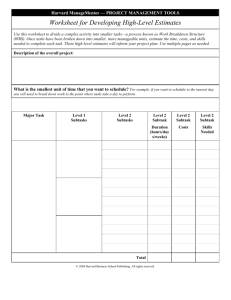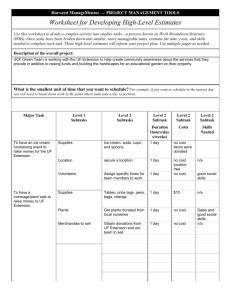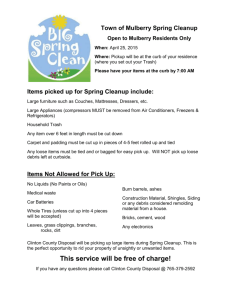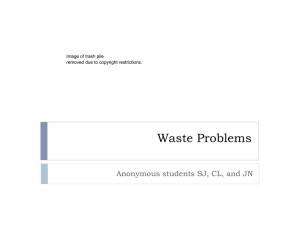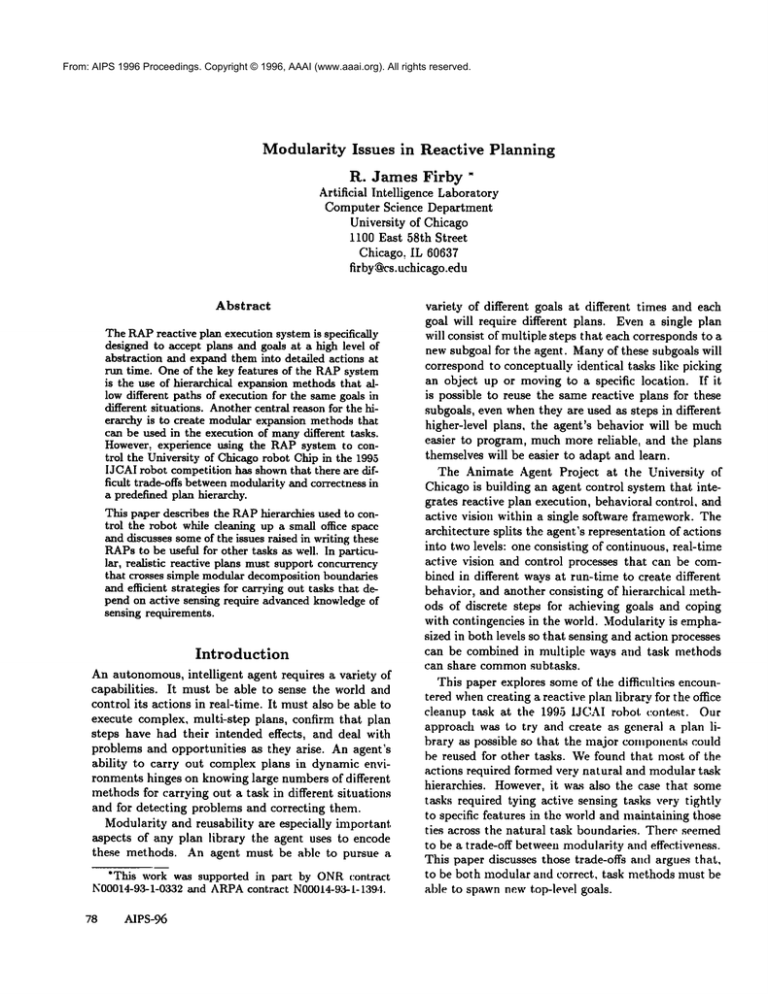
From: AIPS 1996 Proceedings. Copyright © 1996, AAAI (www.aaai.org). All rights reserved.
Modularity Issues
in Reactive Planning
R. James Firby "
Artificial Intelligence Laboratory
Computer Science Department
University of Chicago
1100 East 58th Street
Chicago, IL 60637
firby~cs, uchicago.edu
Abstract
The RAPreactive plan execution systemis specifically
designed to accept plans and goals at a high level of
abstraction and expandthem into detailed actions at
run time. One of the key features of the RAPsystem
is the use of hierarchical expansionmethodsthat allow different paths of execution for the samegoals in
different situations. Anothercentral reason for the hierarchy is to create modular expansion methodsthat
can be used in the execution of manydifferent tasks.
However, experience using the RAPsystem to control the University of Chicagorobot Chip in the 1995
IJCAIrobot competition has shownthat there are difficult trade-offs betweenmodularityand correctness in
a predefined plan hierarchy.
This paper describes the RAPhierarchies used to control the robot while cleaning up a small office space
and discusses someof the issues raised in writing these
RAPsto be useful for other tasks as well. In particular, realistic reactive plans must support concurrency
that crosses simple modulardecompositionboundaries
andefficient
strategies
forcarrying
outtasks
thatdependonactive
sensing
require
advanced
knowledge
of
sensing
requirements.
Introduction
An autonomous, intelligent agent requires a variety of
capabilities.
It must be able to sense the world and
control its actions in real-time. It must also be able to
execute complex, multi-step plans, confirm that plan
steps have had their intended effects, and deal with
problems and opportunities as they arise. An agent’s
ability to carry out complex plans in dynamic environments hinges on knowinglarge numbers of different
methodsfor carrying out a task in different situations
and for detecting problems and correcting them.
Modularity and reusability are especially important
aspects of any plan library the agent uses to encode
these methods. An agent must be able to pursue a
*This work was supported in part by ONRcontract
N00014-93-1-0332and ARPAcontract N000/4-93- [-1394.
78 AIPS-96
variety
of different
goalsat different
timesandeach
goalwillrequire
different
plans.Evena singleplan
willconsist
ofmultiple
stepsthateachcorresponds
toa
newsubgoal
fortheagent.Manyof thesesubgoals
will
correspond
to conceptually
identical
taskslikepicking
an objectup or movingto a specific
location.
If it
is possible
to reusethesamereactive
plansforthese
subgoals,
evenwhentheyareusedasstepsin different
higher-level
plans,theagent’s
behavior
willbe much
easierto program,
muchmorereliable,
andtheplans
themselves
willbe easier
to adaptandlearn.
The AnimateAgentProjectat the University
of
Chicago
is building
an agentcontrol
systemthatintegrates
reactive
planexecution,
behavioral
control,
and
activevisionwithina singlesoftware
framework.
The
architecture
splits
theagent’s
representation
of actions
intotwolevels:
oneconsisting
of continuous,
real-time
activevisionandcontrol
processes
thatcanbe combinedin different
waysat run-time
to create
different
behavior,
andanother
consisting
of hierarchical
methodsof discrete
stepsforachieving
goalsandcoping
withcontingencies
in theworld.Modularity
is emphasizedinbothlevels
sothatsensing
andaction
processes
can be combinedin multiplewaysand taskmethods
can sharecommonsubtasks.
Thispaperexplores
someof thedifficulties
encountered
whencreating
a reactive
planlibrary
fortheoffice
cleanuptaskat the 199~IJCAIrobotcontest.Our
approach
wasto tryandcreateas general
a planlibraryas possible
so thatthemajorcomponents
could
be reusedforothertasks.We foundthatmostof the
actions
required
formedverynatural
andmodular
task
hierarchies.
However,
it wasalsothecasethatsome
tasksrequired
tyingactive
sensing
tasksverytightly
tospecific
features
in theworldandmaintaining
those
tiesacrossthenatural
taskboundaries.
Thereseemed
to be a trade-off
between
modularity
andeffectiveness.
Thispaperdiscusses
thosetrade-offs
andargues
that,
to be bothmodular
andcorrect,
taskmethodsmustbe
ableto spawnnewtop-level
goals.
From: AIPS 1996 Proceedings. Copyright © 1996, AAAI (www.aaai.org). All rights reserved.
The
Animate
Agent
Architecture
The organization of the Animate Agent Architecture
is in two levels. The low level of the architecture is
a collection of soft real-time routines called skills that
can be rearranged into different control loops at different times. At a higher level, the RAPplan execution
system manipulates the set of routines running at any
given time to create a sequence of control states to accomplish a specific task. Skills are meant to capture
those aspects of sensing and action tasks that are best
described in terms of continuous feedback loops while
RAPScapture those aspects of task execution that are
best described as symbolic plans.
Each skill is defined by a separate program and can
be enabled or disabled at will. Whena skill is enabled
it is sent a set of parameters and begins to run. All
running skills can access current sensor values and values generated by other skills on global channels (Gat
1991). Skills can also set actuator and channel values
or constrain the values actuators and channels take on.
Skills are typically enabled in groups that form coherent sets of processes that work together to carry out
specific actions in the world. Skills are programmedto
generate asynchronous signals when they detect that a
task is complete or some problem has occurred. These
signals are caught by the RAPsystem and tell it when
to moveon to the next step in a plan.
The RAPsystem is essentially a reactive plan interpreter. It takes a set of task goals as input (either as
plan from a planner, or in the case of our experiments
as top-level goals) and refines each goal hierarchically
until primitive actions are reached. The hierarchical
plans that define these expansions are the RAPSthat
reside in the RAPlibrary.
The RAPsystem interacts with the skill system using
primitive steps that enable and disable skills, and by
waiting for signals generated by enabled skills. RAPs
are usually structured to enable a meaningful set of
skills concurrently and then wait for that set of skills
to signal successful or unsuccessful completion. More
detail on the RAPsystem can be found in (Firby 1989;
1994).
The
Office
Cleanup
Task
One of the tasks at the 1995 IJCAI Robot Competition
was to pick up all of the trash on an office floor and sort
it into trash and recycling bins. The contest defined
soda cans to be recyclable and paper cups to be trash.
The goal was to correctly sort as manypieces of trash
as possible in a given amountof time. In building skills
and RAPSfor this task, our goal was, and continues to
be, to try to be as modular as possible so they can
be used for other tasks as well. Wehave attempted
to makeas little
trash specific.
of our task representation as possible
Cleanup Skills
One approach we have been using to make skills more
generic is to designate objects in the world indexicalfunctionally as the output of tracking skills (Agre
Chapman1987). For example, we do not have a skill
specific to picking up a piece of trash. Instead, there
is a skill to pick up a small object that is being designated by another skill writing to the target-locat ion
channel. Wecan then pick up a variety of object types
simply by choosing different visual skills to designate
their target-location.
The following visual skills are used in the cleanup
task and are described in more detail in (Firby et al.
1995):
¯ FIND-SMALL-OBJECTS
locates and classifies all of the
small object on the floor in the current visual scene.
¯ FIND-HAUSDORFF-MATCH
locates an area in the image that matches a defined edge model using the
hausdorff distance to rank possible matches.
¯ TRACK-SMALL-OBJECT
runs continuously, tracking
the location of a designated small object in the visual
scene.
¯ TRACK-HAUSDORFF
runs continuously, applying the
Hausdorff matcher repeatedly to track the location
of a knownobject in the scene.
In addition to finding and tracking objects, the
cleanup task required skills for movingthe robot:
¯ MOVE-TO-TARGET
moves the robot to the (z, y) coordinate defined by the target-location
channel
while avoiding obstacles.
¯ ORIENT-TO-TARGET
orients the robot with respect
to (z, y) coordinate defined by the target-location
channel so that the arm can reach the location.
¯ Movedirectly forward or backward a given amount.
The cleanup task also uses several skills for moving
the robot’s arm and gripper. These skills are very simple because CHIPhas a simple four degree of freedom
arm that extends outward in front of its body.
Cleanup
RAPs
The interface between the RAPsystem and the skill
system is in the form of RAPmethods that enable and
disable skills. For the cleanup task, this includes primitive RAPS
for:
¯ Looking for objects.
¯ Tracking objects.
Firby
79
From: AIPS 1996 Proceedings. Copyright © 1996, AAAI (www.aaai.org). All rights reserved.
I pickup
/~move-object
I
I
I
picko
I
Figure 1: Examples of Overlapping Actions
* Moving the pan/tilt head.
* Movingto a target location.
e Orienting to a target location.
e Moving the arm and wrist and gripper.
e Moving forward and backward.
Running these RAPSin parallel allows the construction of a variety of different concurrent skill sets. For
example, approaching a piece of trash requires starting up a tracking skill in parallel with a skill to move
toward the tracked object. Similarly, orienting to an
object so it can be picked up requires tracking the object in parallel with the skill for orienting to the tracked
object.
A hierarchy of more abstract RAPsis built on top
of the primitives. The hierarchy is defined by the subgoals that we believe will be generally useful for other
tasks in the future. Only at the very top of the hierarchy does information specific to trash cleanup come
into play.
The RAPhierarchy specifies general methods for:
e Finding an object.
e Moving to an object.
e Orienting to an object.
e Picking an object up.
* Dropping an object off.
For example, a simplified method from the RAPfor
approaching the current object of interest is shownbelow:
(define-rap
(go-to-object
?radius)
(succeed
(near-object
?radius))
...
(method
(context
(current-object
?type?x ?y))
(task-net
(sequence
(tl (pan-to (angle-to ?x .Ty)))
(parallel
(t2 (track-object ?type ?x .Ty)(until-end
80
AIPS-96
(t3(pan-to-target)
(until-end
(t4(go-to-target))
))
This RAPfirst points the camera in the direction of
the object to be approached. Then, three sub-tasks
are generated to run concurrently:
TRACK-OBJECT
selects and starts up a tracking skill to generate a
target-location to the object being looked at, PANTO-TARGET
starts up a skill to keep the pan/tilt head
pointed in the direction of the target location, and GOTO-TARGET
moves the robot towards the target location while avoiding obstacles. The RAPfor orienting
to an object is very similar. It is particularly important that the plans for approaching and orienting to an
object track the object as the robot is moving. Continually tracking a target to close the visual feedback
loop is an essential error reduction step.
Finally, at the top level of the RAPhierarchy, RAPs
are defined for more cleanup specific behaviors like
movinga piece of trash from the floor to an appropriate trash can and systematically searching the room
for all pieces of trash.
Thus, the l~APs in the cleanup domainform a natural
hierarchy that supports the reuse of subtask plans and
hides manyof the details involved in executing those
subtasks. Picking an object up, or moving an object
from one place to another, are relatively abstract RAPs
in the hierarchy but are excellent operators for use in
other RAPsor plans. Unfortunately, the modularity of
the hierarchy also makes it difficult to describe some
subtask compositions.
Modularizing
Overlapping
Actions
A major problem in creating the cleanup RAPhierarchy is the need, on occasion, to instantiate tasks
that stretch across natural subtask boundaries. Consider two simple actions from the trash cleanup domain: moving an object from the floor to a trash can,
and approaching an object and picking it up. The
MOVE-OBJECT
task very naturally breaks down into
three subtasks: pickup the object, go to the trash can,
drop the object in. Similarly, the PICKUP-OBJECT
task
From: AIPS 1996 Proceedings. Copyright © 1996, AAAI (www.aaai.org). All rights reserved.
move-object
[
-dropoff
I
[ start-
¯
.....
:: .....
Figure 2: Incorporating Overlapping Tasks
breaksdownintothreesubtasks:
approach
theobject,
orient
to bringthegripper
to theobject,
andreachout
to grasptheobject.
In bothof theseexamples,
the naturalbreakdown
of thetasksintosubtasks
is important
because
those
subtasks
canbe,andare,usedto satisfy
a variety
of
othergoalsas well.However,
in bothexamples,
anothersubtask
is required
thatspanssomeof thenatural breakpoints.
As shownin Figure1 MOVE-OBJECT
requires
a taskto monitor
thefactthatthegripper
is holding
thetrashandto reporta problem
if it is
dropped.
Similarly,
PICKUP-OBJECT
requirescontinuallytracking
theobjectduringapproach,
orienting,
and grasping.
The problem is simple: How can we write RAP
methods for the reusable steps in MOVE-OBJECT
and
PICKUP-OBJECT
so they are also compatible with the
overlapping subtasks needed to complete the methods
PICKUP-OBJECTand MOVE-OBJECT
themselves?
with maintaining useful modular subtasks.
Naive Decomposition
Another solution for dealing with subtasks that extend across natural decomposition boundaries is to cut
them into non-overlapping pieces. For example, we
can cut the MONITOR-HAND
subtask in the decomposition for MOVE-OBJECT
into three pieces as shown in
Figure 3. The pickup subtask uses a MONITOR-HAND
subtask in parallel with lifting the arm up, the goto subtask turns into a carry subtask that includes
a MONITOR-HAND
in parallel with the go-to, and the
dropping off subtask includes MONITOR-HANDuntil the
(define-rap
(carry)
°.o
(parallel
(tl(monitor-hand)
(until-end
t2))
(t2 (go-to))))
(define-rap
(pickup)
Explicit
Parallelism
The most direct way to incorporate overlapping tasks
into methods is to explicitly encode the required parailelism into the task decomposition. For example, one
might encode MOVE-OBJECT
to do PICKUP, then GOTO in parallel with MONITOR-HAND,
and finally DROPOFF. Specifying a concurrent task to monitor a state
in this way is similar to the policy construct in the RPL
language (McDermott 1992; 1991).
Unfortunately, to get the correct overlap for the
MONITOR-HAND
task, its end-points must be pushed
down the task hierarchy, as shown in Figure 2, below the level of abstraction where pickup, go-to, and
drop-off are modular units. The resulting reorganization of subtask structure under MOVE-OBJECT
(and the
similar one required for PICKUP-OBJECT) destroys the
modularity inherent in the natural subtask decomposition of the trash cleanup domain.
Parallelism is the representational goal, but directly
encoding it into higher-level methods is incompatible
*°°
(sequence
(tl (position-arm
down))
(t2(grasp))
(parallel
(t3(monitor-hand)
(until-end
(t4(position-arm
up)) )
move-object[
I
g
I
Figure 3: Dividing an Overlapping Task into Pieces
From: AIPS 1996 Proceedings. Copyright © 1996, AAAI (www.aaai.org). All rights reserved.
move-object [
pickup
I
dp-off
I
~ monitor-hand
Figure 4: Spawning Monitoring Tasks
object is ungrasped. Using this decomposition, pickup,
carry, and drop-off becomeseparate tasks that can be
composed in sequence without worrying about a separate MONITOR-HAND
subtask. The problem of overlapping tasks has gone away.
This solution to the problem often works quite well
(and was used on our robot at the actual competition)
but it won’t work in general. In particular, applying
this solution to the PICKUP-OBJECT
task requires cutting the visual tracking task into three pieces: one to
be part of the approach task, one to be part of the orient task, and one to be part of the grasp task. Splitting
up a visual tracking task in this way can cause tracking problems at task boundaries. Wheneverything in
the world is stationary, the final state of one tracking
task can be fed into the next to maintain continuity
(i.e., perhaps the image centroid of the object being
tracked as last seen by the orient task might be passed
to the tracking component of the grasp task). However, when the object to be grasped is moving or the
world is changing quickly, maintaining a positive visual
lock on the desired object requires continuous tracking.
Stopping and starting the tracker at task boundaries
creates a lack of continuity that can cause target loss.
The Real
Problem
It is important to understand at this point that the
problem of encoding overlapping tasks while maintaining modularity is not a planning problem. The issue
is not how, or whether, to generate a task for monitoring the hand or for tracking an object, but rather
how to properly describe the scope of such a task. In
particular, we are interested in encoding tasks that are
conceptually concurrent at a high level of abstraction,
but which must be synchronized with subtasks hidden
much further down in the hierarchy. Deciding what to
monitor and detecting and correcting interactions between independent RAPtasks are independent issues.
Neither of the two simple solutions to the problem
of encoding overlapping steps described above -- the
82 AIPS-96
division of overlapping steps into pieces that match the
other subtasks, and the use of explicit parallelism to
directly represent the overlapping required .... is completely adequate. The only way to correctly represent
the required task combinations is to encode the dynamic creation of independent goals.
Spawning
Tasks
’Ib correctly solve the problem of including overlapping tasks in modular plans, the method description
semantics must be extended to allow the creation of
independent subtasks. With this ability, the MOVEOBJECT method can be encoded as shown in Figure 4. The subtasks for picking up the object, going to the destination, and dropping the object off are
all treated as independent. Downwithin the expansion of PICKUP-OBJECT.
after the object is grasped, a
MONITOR-HAND
is always spawned to watch for the object to be dropped. This task lives on after the PICKUPOBJECTstep completes, running concurrently with going to the destination (or any other task that might
be attempted while holding the object) and the first
part of dropping the object off. Then, down within
DROP-OFF-OBJECT,
when the object is released, the
MONITOR-HAND
task is terminated.
Issues in Spawning Independent Tasks Allowing methods to spawn and terminate independent tasks
provides a way to scope the lifetime of concurrent tasks
over modular subtask boundaries. However, there are
additional details required to makc things work correctly. First, a spawned task needs to be named so
that it can be referred to by later, independent methods. For example, the subtask under MOVE-OBJECT
for dropping an object off must be able to terminate
the MONITOR-HAND
task started by the completely independent pickup task. Similarly.. the subtasks under
PICKUP-OBJECT
are supposed to be generic tasks for
approaching and object, orienting to it, and reaching
out to grasp it. All three require a tracking task to be
running and hence need to start one if none already
From: AIPS 1996 Proceedings. Copyright © 1996, AAAI (www.aaai.org). All rights reserved.
exists (if the orient task is used as the first step in
method for example). To prevent the creation of multiple tracking tasks, each of these subtasks must be able
to check to see whether an appropriate tracking task is
already running. A named global tracking task makes
this check possible.
Second, there must be a way to tie the spawned task
to the overall goal it is part of so that goal can be
told about problems with the spawned task. For example, suppose the gripper drops a piece of trash while
the robot is going to the trash can. The spawned
MONITOR-HAND
task can be written to notice this
problem and stop the robot to pick the trash up again.
However, what should happen if the trash has rolled
under a table and cannot be located? The MONITORHANDtask must be able to signal this problem to the
MOVE-OBJECT
task so it can deal with the failure.
Introducing constructs into the RAPlanguage for
spawning and naming tasks, terminating tasks, and
intercepting signals gives the method fragments shown
in Figure 5 for the MOVE-OBJECT
task. The method for
MOVE-OBJECT
uses three steps and during those steps
will fail ifa (lost-object) signal is generated. Within
the PICKUP-OBJECTmethod, a MONITOR-HAND
task
named .’?task is created and a notation is made in RAP
memory. Within the DROP-OFF-OBJECT
RAP a method
is included that checks whether there is a monitoring
task, grabs its name from memory,and then terminates
it just before the object is ungrasped. Notice that the
PICKUP-OBJECT and DROP-OFF-OBJECT remain selfcontained in achieving their primary goals. PICKUPOBJECTdoes not care how the MONITOR-HAND
task is
used or what it does, and the DROP-OFF-OBJECT
task
drops the object whether the hand is being monitored
or not. Notice also that there is no need for a separate
"carry" goal, the go to destination task can be used
directly because the MONITOR-HANDtask is spawned
by the pickup method. The hand monitor task is created and terminated exactly when it should be: when
an object is grasped and ungrasped. These RAPs together implement a policy without collapsing the task
hierarchy.
Orphaned Tasks A final complication in allowing
spawned tasks is what to do should the MOVE-OBJECT
method fail for some reason such as the destination being unreachable. In this case, the subtasks explicitly
used in the method will go away, (i. e., PICKUP-OBJECT,
GO-TO, and DROP-OFF-OBJECT) but the independent
spawned MONITOR-HAND
task will be left because it
is essentially
unknown to the MOVE-OBJECT
method
(except that MOVE-OBJECT
is encoded to expect a signal from it). This anonymity is what leaves the other
subtasks modular and reusable and it cannot be aban-
(define-rap
(move-object
?container)
oo.
(on-event
(lost-object)
:fail
(sequence
(tl (pickup-object))
(t2 (go-to ?container))
(t3 (drop-off-object)))))
(define-rap (pickup-object)
.oo
(sequence
(tl (start-pickup))
(t2 (grasp))
(t3 (spawn (monitor-hand) ?task)
(mem-add (monitoring-hand ?task)))
(t4 (finish-pickup))))
(define-rap (drop-off-object)
o.o
(method
(context (monitor-hand ?task))
(task-net
(sequence
(tl (start-drop-off))
(t2 (ungrasp))
(t3 (terminate ?task))
(t4 (finish-drop-off)))))
(method
(context
(not (monitor-hand
?task)))
(task-net
(sequence
(tl (start-drop-off))
(t2 (ungrasp))
(t3 (finish-drop-off))))))
Figure 5: RAP Methods for the Move-Object Task
doned. Furthermore, it makes a certain amount of
sense for the MONITOR-HAND
task to persist as long as
the hand is holding the object, even if it is no longer
holding it for a purpose.
So, the easiest solution is for the MONITOR-HAND
task to live on until the object is actually put down,at
which point the DROP-OFF-OBJECT
task (or any other
put downtask) will explicitly terminate it.
The TRACK-OBJECT
subtask of PICKUP-OBJECT
has
a somewhatdifferent semantics. In this case, the subtask is supposed to maintain a continuous designation
of the object being tracked for the subtasks to use. Unlike the MONITOR-HAND
subtask, there is little point
in the tracking task continuing to run after the tasks
needing its information have gone away. Worse, when
a new task requiring the vision system begins to run,
the orphaned tracking task may interfere. Within the
RAPsystem it is possible to get around this problem
by careful use of tracking task names (so that an old
tracker will not be assumed to work for a new object),
specification of a software "tracking resource" that new
F~rby 83
From: AIPS 1996 Proceedings. Copyright © 1996, AAAI (www.aaai.org). All rights reserved.
tracking tasks take from old ones causing the old ones
to terminate, and encoding tracking tasks to terminate
whenthey lose track of their target. However,the right
solution is to include more generic goal knowledge to
terminate orphan tracking tasks when the higher-level
tasks that caused their creation go away.
Spawning
Tasks
and
RAP Semantics
The discussion above argues that the only way to create modular task descriptions that also include overlapping concurrent tasks to designate and monitor features in the world is to include the ability to spawn
independent, named tasks in the task description language. Without this ability, there is no way to create
the appropriate monitoring or tracking tasks at exactly
the points where the states involved becometrue deep
within generic task decompositions. Task expansion
methods must be able to create, terminate, and refer to other tasks without regard to where those tasks
might have come from.
Giving the RAPsystem the ability to refer to and
alter the overall task state ill this way is a significant
change in the expressive power of the RAPlanguage.
As a strictly hierarchical language, RAPmethods can
create task expansions of arbitrary complexity, but the
scope of tile subtasks in a methodis well defined and
they have no effect on other methods
a RAPtask
can manipulate only the subtasks it spawns. However,
giving methods the ability to alter the top-level goals
of the system (by spawning and terminating top-level
tasks) means that RAP methods can control tim way
that RAPexpansion proceeds.
Allowing RAPmethods to spawn new, independent
tasks is required to make subtask descriptions more
nmdular so they are easier to combine. However,
care nmst be taken because allowing new tasks to be
spawned in this way can make the semantics of RAP
representations considerably more obscure.
Opportunistic Task Creation
Another problem encountered while developing RAPS
and skills for the IJCAI office cleanup task is that of
knowing when to do passive visual sensing to support
goals that are not yet active. In particular, while the
robot looks for trash, it wouldbe nice, and more efficient, if it was also looking for trash cans with whatever spare processing resources are available. Similarly,
when looking for trash cans it would be nice to notice
trash.
This problem can be solved by simply writing the
SEARCH-FOR-TRASH
task to run a paralleltask to
WATCH-FOR-TRASII-CANS
and vice versa. However,
thissolution
overlaps
specific
tasksin a verynon84 AIPS-96
modular way. It would be much more useful for the
WATCH-FOR-TRASH-CANS task
to be generated automatically when trash cans will be relevant in the future.
For example, consider the schematic RAPfragment
for throwing away a piece of trash shown below:
(def
ine-rap
(toss-out-trash)
o..
(sequence
(tl (search-for-trash))
(t2 (pickup-object))
(t3(search-for-trash-can))
(t4(go-to-object))
(t5 (drop-off-held-object)))
Thismethodshowsa relatively
modularbreakdown
of
thetaskof tossing
outa single
piece
of trash.
However,
thesimple,
sequential
breakdown
of thetaskdoesnot
takeintoaccount
thepotential
efficiencies
of noting
thelocations
oftrashcansseenwhile
looking
fortrash.
Whensteptl is running,
t3 simplywaitsitsturnand
novisual
processing
effort
is putintolooking
fortrash
cans.
In general.,
anticipating
opportunities
is a planning
problem
thatrequires
looking
intothefuture,
noting
expected
sensing
needs,andthencreating
a taskplan
thatincludes
early,opportunistic
sensing
steps.
However,it is possible
to extend
theRAP system
to exploit
suchopportunities
in certain
limited
situations.
Onewouldliketo adda ruleto thesystemof the
form:Whena RAP methodincludesthe stepSEARCHFOR-TRASII-CAN,
add a step WATCH-FOR-TRASH-CAN
in parallel
withthe wholemethod.Assuming
WATCHFOR-TRASH-CAN
is basicaily
a passive
visualtaskthat
examines
images"inthe background,"
applying
this
rulewhentheTOSS-OUT-TRASH
methodis instantiated
willadda taskto theexpansion
thatwon’tinterfere
withotherstepsin the methodand mightsavesome
timelaterbynoticing
a trashcanthatwouldotherwise
haw~beenmissed.
ThePRS systemsupports
suchrules
as meta-KAs
(Georgeff,
Lansky,& Schoppers
1986).
Similarrulescan bc usedto addresssomeof the
problems
withoverlapping
tasksdiscussed
in theprevioussection,
l~brexample,onemightwanta rule
thatsays:Whenever
a GRASPactionis takenas part
o/theexpansionof MOVE-OBJECT,
a MONITOR-HAND
taskshouldbe created.
Thiscouldbe combined
witha
rulethatsays:Whenever
an UNGRASPactionis taken
whilea MONITOR-HAND
taskis running,
terminate
the
MONITOR-HAND. Theresultwillbe the samebehavior
as methods
containing
stepsthatexplicitly
spawnand
terminate
the MONITOR-HAND
task.
Moregenerally,
rules
ofthissortarea wayto specify
modifications
to theRAPsystem’s
current
setof goals
outside
of theusualconstraints
of hierarchical
expan-
From: AIPS 1996 Proceedings. Copyright © 1996, AAAI (www.aaai.org). All rights reserved.
sion.Theyarea simplewayof modifying
thetasksin
a methodbasedon anticipated
interactions
withother
tasksthesystemknowsabout.Theycan alsobe seen
as a wayof specifying
patches
to RAP methods
without
rewriting
themethods
themselves.
Theconcept
of programmingreactivemethodsand thenaddingpatches
as dimcult
situations
areencountered
is discussed
by
Simmonsin (Simmons1994).
A mechanism
fordefining
RAPsystemrulesto be invokedwhenspecific
taskexpansion
patterns
occurhas
not yet beencompletely
defined.
However,the need
to recognize
andexploit
opportunities
likethepassive
sensingexample
abovealongwiththe powerin defining modifications
and patchesoutsideof the normal
expansion
hierarchy
hasmotivated
itsdevelopment.
Conclusions
Thispaperdiscusses
twoproblems
encountered
while
constructing
RAP taskdescriptions
foranoffice
cleanup
task.Oneproblemis the requirement
thatsometasks
monitoring
statesin the worldextendcontinuously
acrossotherwisemodularsubtaskboundaries.
The
otherproblem
is anticipating
taskinteractions
andopportunities
andaltering
theRAP system’s
goalstructurein response.
Twosolutions
to theseproblems
werediscussed
and
both acknowledgethat there must be a mechanism
in theRAP language
forcreating
new top-level
tasks
withinexpansionmethods.It must be possibleto
spawntasksat the pointin an expansion
whenthey
becomerelevant
relevant
and thenlet themrun continually
across
succeeding
independent
steps.
Thefirstsolution
is to augment
theexisting
RAP languageto support
thecreation
andtermination
of independent,
namedtasks.Coupling
thesetaskswiththe
ability
to sendandintercept
signals
allowsa method
to be builtfromstepsthatstartandstopauxiliary
tasksandcancatchmessages
fromthosetasks.Using
theseconstructs
it is simple
to encodeboththeMOVEOBJECT taskto continuously
watchfortheobjectto be
dropped,
and the PICKUP-OBJECT
taskto continuously
tracktheobjectwhileit linesup and grasps.With
thisapproach,
subtasks
mustexplicitly
knowwhenand
whatauxiliary
tasksto spawnand terminate
without
directknowledge
of whatsortof expansion
theyare
taking
partin.
Thesecondsolution
is to createa newlanguage
for
rulesthatwatchforpatterns
of taskinstantiation
and
worldstateto occurandthencreateor terminate
additional
tasks.Thisapproach
acknowledges
thatall
tasksareexecuted
in thecontext
of othertasks,and
thatone of the mainproblemsin creatingmodular
subtasks
is sorting
outtaskinteractions.
Thewayto
achieve
a goalintheworldis to beginexecuting
a set
of cooperating
tasksthatcanbe changed
viataskrules
as execution
proceeds.
In thissituation,
oddcircumstances,
likewhatto do if an objectis dropped
or a
tracked
objectis lost,canbe seenas patches
to the
current
active
goalstructure.
Thefirstsolution
is currently
beingimplemented
in
theRAP system.Thesecondis beinginvestigated
in
themoregeneralcontextof incorporating
a planner
withflexible
goals.
Theseresults
suggest
thatanyreactive
planexecutionsystemthatdesiresto hidecomplexity
froma
plannerusinga hierarchy
of modularsubtasksmust
be ableto manipulate
itsowninternal
tasksandtask
states.
A taskplanmustbe ableto createnewtasks
thatareunconstrained
by thecurrent
taskrefinement
hierarchy,
andto referto andacton anytaskwithin
thesystem,
notjustthosecreated
as subtasks.
Withouttheseabilities,
taskplanscannot
be mademodular
at appropriate
levels
ofabstraction
andthereisno way
toshield
higher
levelsystems
fromthedetails
of interactingwiththeworld.
References
Agre, P. E., and Chapman,D. 1987. Pengi: An implementation of a theory of activity. In Sizth NationalConference
on Artificial Intelligence, 268-272. Seattle, WA:AAAI.
Firby, R. J.; Kahn,R. E.; Prokopowicz,P. N.: and Swain,
M. J. 1995. Anarchitecture for vision and action. In Fourteenth International Joint Conferenceon Artificial Intelligence, 72-79.
Firby, R. J. 1989. Adaptive execution in complex dynamic worlds. Technical Report YALEU/CSD/RR
#672,
ComputerScience Department, Yale University.
Firby, R. J. 1994. Task networks for controlling continuous processes. In SecondInternational Conference on A[
Planning Systems, 49-54.
Gat, E. 1991. Reliable Goal-Directed Reactive Control
of AutonomousMobile Robots. Ph.D. Dissertation, Computer Science and Appfications, Virginia Polytechnic Institute.
Georgeff, M. P.; Lansky,A. L.; and Schoppers,M. J. 1986.
Reasoning and planning in dynamic domains: An experiment with a mobile robot. Tech Note 380, AI Center, SRI
International.
McDermott,
D. 1991.A reactive
planlanguage.
Technical
ReportYALEU/CSD/RR
#864,YaleUniversity
Departmentof Computer
Science.
McDermott,
D. 1992.Transformational
planning
ofreactivebehavior.
Technical
ReportYALEU/CSD/RR
#941,
YaleUniversity
Department
of Computer
Science.
Simmons,
R. 1994.Becoming
increasingly
reliable.
In
SecondInternational Conferenceon A I Planning Systems,
152-157.

